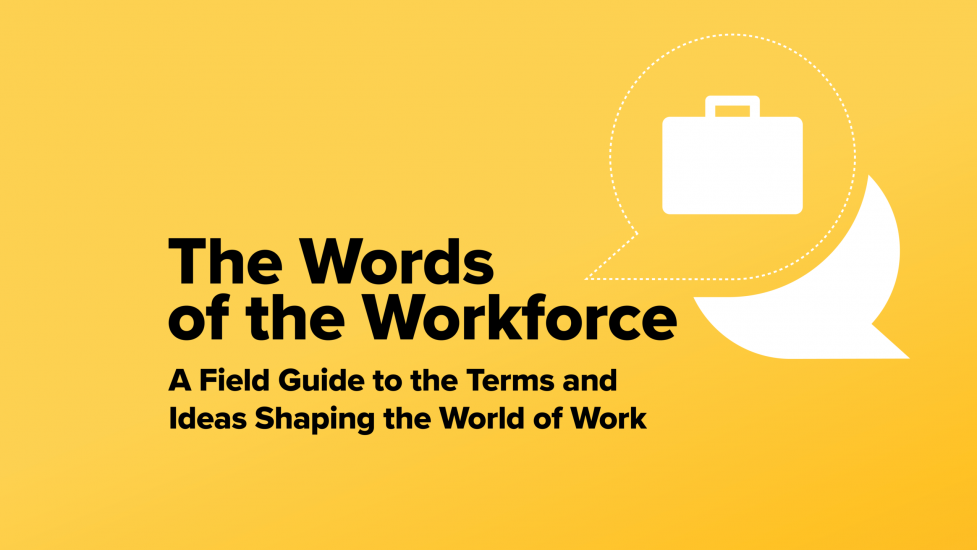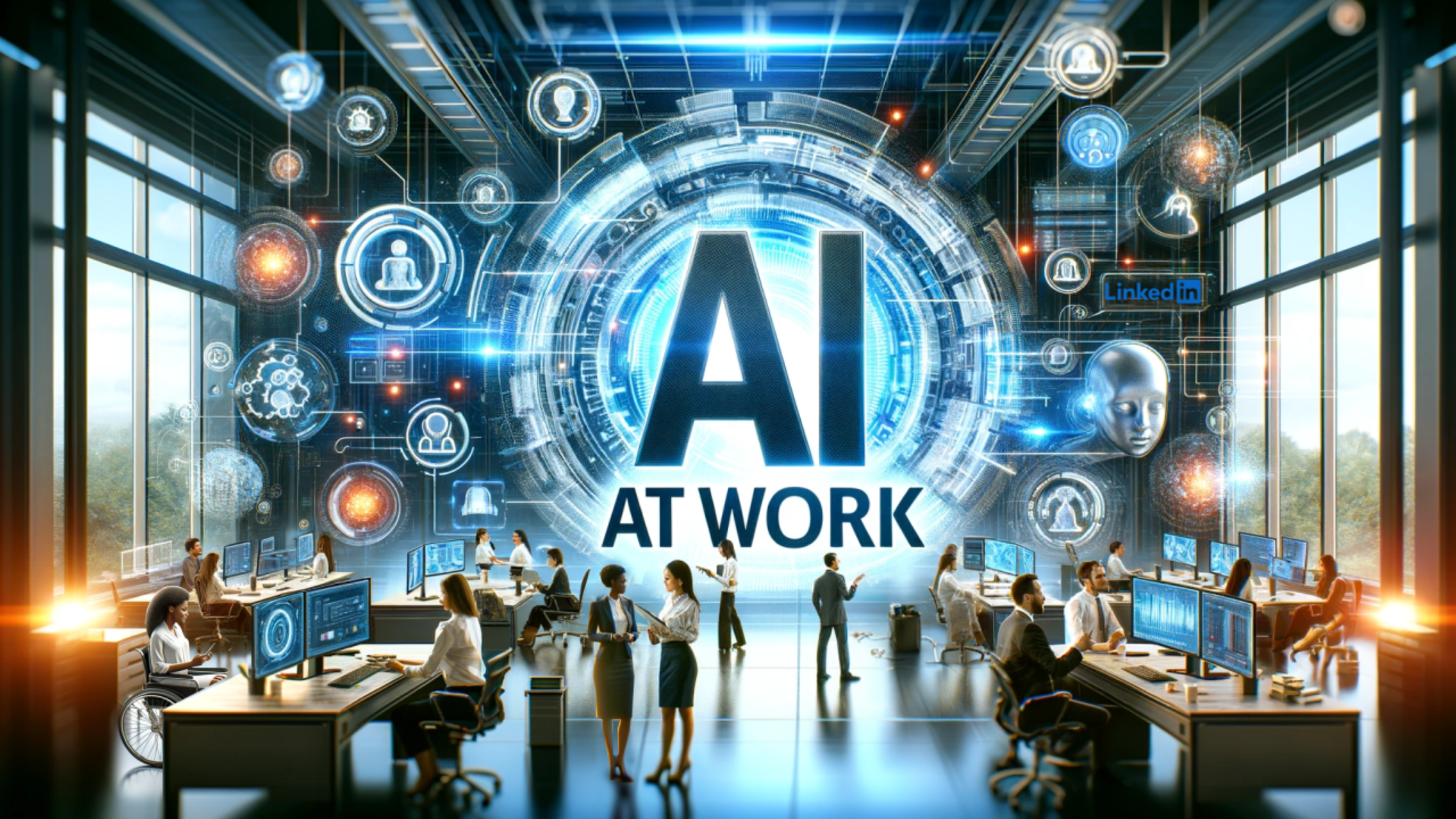Introduction
America’s workforce is undergoing unprecedented change. In the wake of the COVID-19 pandemic and its associated impact on the labor market, workers and job seekers are finding themselves empowered to demand more from their employers—and business leaders are making renewed commitments to supporting their employees. Despite this shift, there are still many people facing barriers to economic mobility, with millions out of work as the country navigates a rocky road to economic recovery.
The seismic effects of the pandemic have generated increased media attention on issues of workforce development, economic mobility, and opportunity. But as is so often the case, the more prevalent a given issue becomes in the national narrative, the muddier the terminology used to describe that issue becomes. Today, there is a lack of a strong, clear definition for many words in the lexicon of workforce development.
To address that challenge, a collaborative team of stakeholders and subject matter experts from several workforce-related organizations has developed this new field guide, which serves as an overview of key terms and concepts related to workforce development.
The guide is divided into thematic sections, each of which includes a number of terms related to workforce development. We hope it fosters a better understanding of preferred terms and how to use them with clarity.
Our goal is not to prescribe definitions that will always apply in every case. Rather, it is to shed light on the way that critical terms are (and are not) used, so that journalists, analysts, and advocates can move toward a shared lexicon for an increasingly critical issue in the national discourse.
In addition, this is a living document, and one that draws on the great work and advocacy of organizations like JUST Capital that have also promoted the need for more precise language around workforce development. We look forward to continued feedback, input, and critiques that can help make this document as helpful as possible.
Framing for Equity
We are encouraged to see the media acknowledge greater awareness to report through a more intentional lens of diversity, equity, and inclusion (DEI). In addition to the definition and use of specific terms, we hope to encourage an approach that promotes further equity through the specific and thoughtful use of language.
Much of the narrative around U.S. workforce challenges adheres to what might be called an “individual deficit” model: employers face labor shortages because workers lack the appropriate skills, credentials, or training. The workforce development system has historically focused on addressing these individual deficits to meet employer needs or market demand. This narrative tends to minimize the role of workforce-adjacent issues and systems that prevent workers from succeeding and thriving (e.g., employer practices, accessible and affordable child care and transportation, housing, mental health services, etc). Undergirding all of this is the living legacy of systemic racism, which continues to be reflected in the challenges that so often face workers and job seekers from historically underrepresented racial and ethnic groups.
While, as communicators, we all try to economize the number of words in our pieces, it more accurately reflects today’s reality when we don’t ascribe the systemic condition to the individual. For example, instead of “low-skill worker,” a growing number of organizations use phrasing like “people who work in low-wage jobs.” As we consider the role of language in shaping how policy and practice are formed, these shifts play an increasingly important role in reframing the conversation around the respective roles of individuals and systems in the labor market.
For more information on this important topic, we recommend sources like Workforce Matters; the National Fund for Workforce Solutions’ reports on advancing workforce equity; the Roosevelt Institute’s report on skills development and worker power; and here at WorkingNation.com.
About the Authors
The guide was a collaborative effort of a diverse group of nonprofit organizations focused on workforce policy and equity issues. We’re grateful for the partnership, insight, and contributions of Opportunity@Work, Strada Education Network, National Fund for Workforce Solutions, SkillUp, Talent Rewire, Whiteboard Advisors, America’s Promise, Cognizant Foundation, Grads of Life, JFF, National Skills Coalition, New Profit, and WorkingNation.

The Words of the Workforce
Definitions
Skills

Reskilling, upskilling: These terms are sometimes used interchangeably, but they can also refer to different ideas. Reskilling can be used to describe the process of learning entirely different skills to meet the demands of a new job, while upskilling can refer to a worker augmenting their existing skills to reflect the shifting needs of their employer.
Read more:
https://www.digitalhrtech.com/upskilling/#What
https://www.nationalskillscoalition.org/resource/publications/the-business-case-for-upskilling/
https://www.talentguard.com/blog/reskilling-upskilling-strategic-response-changing-skill-demands
https://www.nationalskillscoalition.org/wp-content/uploads/2020/12/The-Business-Case-for-Upskilling.pdf
https://stradaeducation.org/report/on-ramps-to-good-jobs/

Skills-based hiring: The practice of setting specific skill or competency requirements for job roles, rather than using requirements like degree attainment. This method has gained traction among employers and workforce development advocates as a way to screen candidates for the skills they have, rather than screening them out for the credentials they lack. Some organizations use “skills-first hiring” to refer to the same principle.
Read more:
https://www.shrm.org/hr-today/news/hr-magazine/0318/pages/hiring-for-skills-not-pedigree.aspx
https://opportunityatwork.org/key-topics/skills-based-hiring/
https://stradaeducation.org/report/the-new-geography-of-skills/

Human skills, soft skills, professional skills: Human or soft skills are often used to refer to skills that are less able to be automated, and that are highly transferable across jobs or occupations (e.g., teamwork, communication, critical thinking, creativity).
The term “professional skills” is used differently by different organizations. For some, it is used interchangeably with “human skills,” since human skills are required in nearly every profession. For others, it refers to the technical know-how or expertise one brings to the job, though those are also often known as “technical skills” or “hard skills.”
Some researchers and advocates also note that the term “professional,” used in this context, often implies favoritism for the sort of norms and practices prevalent in white-dominant culture.
Read more:
https://www.livecareer.com/resources/resumes/basics/job-skills-values
https://trainingindustry.com/glossary/hard-skills/
https://trainingindustry.com/glossary/soft-skills/
https://stradaeducation.org/report/robot-ready/

Skill(s) gap: Generally, the perceived discrepancy between the skills employers are looking for and the skills they believe they can access in the workforce.
Crucially, this discrepancy is not a monolith—it can vary widely among different regions, industries and individuals. LinkedIn’s Economic Graph, for instance, is designed to quantify skill gaps across various sectors of the labor market—which can also include skills surpluses (e.g., when there are more workers in a given area with a certain skill than employers who need that skill). It also may be a communications gap, as companies and workers describe competencies in ways the other misunderstands—even if the worker does actually have the desired capabilities.
A growing number of organizations are abandoning the “skills gap” language in favor of terms like “skills mismatch,” which recognizes that the challenge may be a disconnect between the specific, job-aligned skills sought by employers, and the skills that workers already possess.
Read more:
https://trainingindustry.com/glossary/skills-gap
https://www.brookings.edu/research/understanding-the-skills-gap-and-what-employers-can-do-about-it/
https://www.shrm.org/resourcesandtools/tools-and-samples/how-to-guides/pages/how-to-address-the-skills-gap.aspx
https://www.nationalskillscoalition.org/skills-mismatch/
Jobs

Good job, quality job, decent work: These terms often are used interchangeably to describe the kind of outcome many policymakers and advocates are working for—jobs with a fair wage that allow individuals to sustain the health and wellbeing of themselves and their families.
Read more:
https://www.ilo.org/global/topics/decent-work/lang–en/index.htm
https://nationalfund.org/our-solutions/activate-employers-to-make-jobs-better/job-quality-resource-center/defining-job-quality/
https://www.aspeninstitute.org/longform/job-quality-tools-library/section-1-understanding-job-quality/
https://stradaeducation.org/employers/how-work-changed-for-good-in-2020-according-to-employers/
https://cci.stradaeducation.org/pv-release-november-12-2020/

Middle-wage work: Higher than entry-level or frontline, middle-wage jobs provide a greater opportunity for growth into higher-wage jobs and build on skills developed in entry-level positions.
Read more:
https://money.usnews.com/money/personal-finance/family-finance/articles/where-do-i-fall-in-the-american-economic-class-system
https://opportunityatwork.org/our-solutions/stars-insights/navigating-stars-report/

Meaningful work: Work that is fulfilling and satisfying and is aligned with personal values and personal measures for success.
Read more:
https://www.forbes.com/sites/rebeccafraserthill/2019/08/07/the-5-biggest-myths-about-meaningful-work/?sh=79ebcdea70b8
https://www.brookings.edu/blog/up-front/2020/04/08/what-makes-a-job-meaningful/
https://www.shrm.org/hr-today/news/all-things-work/pages/the-search-for-meaning.aspx
Degrees and Credentials

Certificate, certification: The two terms are sometimes used interchangeably to describe a postsecondary credential that typically requires less time (and less money) than a 2- or 4-year degree. But many certificate and certification providers use them to refer to specific and distinct things.
- A certificate is granted as a result of an educational experience, with content determined through an academic process.
- A certification is granted as a result of an assessment, with content designed based on standards set by the industry in which the certification is being granted.
The former can be “stacked” to serve as a gateway to another educational credential, like a degree; the latter has no direct relationship to higher education but is more directly applicable in business contexts.
Read more:
https://credentialengine.org/wp-content/uploads/2021/02/Counting-Credentials-2021.pdf
https://www.scps.virginia.edu/certificate-vs-certification
https://stradaeducation.org/on-purpose/things-to-know-now-about-the-future-of-nondegree-credentials/
https://cci.stradaeducation.org/pv-release-july-28-2021/#
https://cci.stradaeducation.org/report/certified-value/

Microcredentials, MicroMasters, nanocredentials: Forms of certification earned by proving competence in one (or a few) specific skill(s) at a time. Microcredentials are becoming increasingly popular in short-form, online training programs.
Read more:
https://evolllution.com/programming/credentials/microcredentials-micromasters-and-nanodegrees-whats-the-big-idea/
https://bloomboard.com/what-are-microcredentials/
https://www.udacity.com/blog/2016/07/nanodegree-101.html
https://credentialengine.org/wp-content/uploads/2021/02/Counting-Credentials-2021.pdf
https://www.nationalskillscoalition.org/resource/publications/credential-quality-and-transparency-are-important-for-an-inclusive-equitable-recovery/
https://www.nationalskillscoalition.org/resource/publications/expanding-opportunities-defining-quality-non-degree-credentials-for-states/

Degree inflation: The practice of preferring or requiring a college degree (or other advanced degree) for positions that traditionally have not required that level of education. A fairly recent trend that has largely evolved in the wake of the 2008 recession, degree inflation leads to skilled workers being unable to compete for jobs for which they traditionally would have been qualified, and puts unnecessary costs onto workers who believe they have to get a degree to do that work.
Read more:
https://thehill.com/opinion/education/477825-degree-inflation-like-grade-inflation-hurts-workers-as-it-does-employers
https://gradsoflife.org/dismissed-by-degrees
Workers

Opportunity youth: 16- to 24-year-olds who are neither in school nor participating in the labor market.
Read more:
https://aspencommunitysolutions.org/who-are-opportunity-youth/
https://www.aypf.org/youth-populations/opportunity-youth/
https://workingnation.com/connecting-opportunity-youth-to-community/

Opportunity talent, opportunity employers, opportunity employment: “Opportunity” is often added to any number of workforce and education terms to denote individuals from historically untapped talent pools—such as opportunity youth, individuals with disabilities, veterans, and formerly incarcerated individuals—who seek economic stability through employment. These populations tend to be historically underrepresented racial and ethnic groups.
- Opportunity talent refers to the talent pool itself.
- Opportunity employers are those who refine their talent management systems to support the retention and advancement of opportunity talent.
- Opportunity employment is a commitment to recruitment, hiring, and retention and advancement practices that prioritize equity, inclusion, opportunity, and mobility.
Read more:
https://www.forbes.com/sites/gradsoflife/2020/08/13/leveraging-opportunity-employment-to-advance-racial-justice-in-corporate-america/?sh=2a97ed0d252f
https://www.cnbc.com/2018/08/16/15-companies-that-no-longer-require-employees-to-have-a-college-degree.html
https://www.forbes.com/sites/gradsoflife/2021/05/27/companies-hiring-from-community-colleges-have-a-leg-up-heres-why/?sh=7fc9db5f3354
https://www.fsg.org/opportunity-employment
https://www.opportunitynavigator.org/opportunity-employment/
https://gradsoflife.org/opportunity-employer-principles/

Opportunity gap: Disparities in access to education, training, or pathways to economic mobility for individuals from traditionally untapped talent pools (e.g., people without a two- or four-year degree) who seek economic stability through employment, and from historically underrepresented racial and ethnic groups.
Read more:
https://opportunityatwork.org/problem/
https://www.brookings.edu/blog/the-avenue/2020/09/09/the-labor-market-doesnt-have-a-skills-gap-it-has-an-opportunity-gap/

Work-based learning: On-the-job experiences during an educational course of study (and often for academic credit of some kind) that lead to improved career opportunities. Examples include apprenticeships, internships, and other models.
Read more:
https://ied.eu/project-updates/what-is-work-based-learning-and-what-are-the-benefits/
https://www.aeseducation.com/blog/what-is-work-based-learning
https://www.nationalskillscoalition.org/wp-content/uploads/2020/12/Partnering-Up-Brief-FIN-LOW-RES.pdf
https://hechingerreport.org/opinion-why-every-high-school-student-needs-a-work-based-experience/
https://cci.stradaeducation.org/pv-release-november-12-2020/

STARs: First coined by Opportunity@Work, this acronym stands for Skilled Through Alternative Routes and refers to U.S. workers with employment skills but no four-year degree.
Read more:
https://www.shrm.org/hr-today/news/hr-magazine/0318/pages/hiring-for-skills-not-pedigree.aspx
https://opportunityatwork.org/our-solutions/stars-insights/reach-stars-report/

Midcareer workers: Workers who have been in the workforce for more than a decade. During a time of accelerating change in the labor market, these workers may face significant barriers to reentry into the workforce, particularly if they do not yet have the tech-oriented skills that a growing number of employers demand for today’s increasingly digital economy.
Read more:
https://theconversation.com/techs-next-great-opportunity-is-mid-career-workers-103217
https://workingnation.com/meeting-the-midcareer-moment-the-challenges-of-the-45-jobseeker/

Frontline workers: Workers who work in close proximity to the public. This can include individuals working in health care, food services, and customer service. Frontline work is performed onsite and requires being close to the public (e.g., one’s customers) or co-workers.
Read more:
https://www.fsg.org/publications/advancing-frontline-employees-color
https://www.fsg.org/publications/advancing-frontline-women

Essential workers: Workers who conduct a range of operations and services in industries that are thought of as “essential” to the functioning of society. In the wake of the pandemic, the Economic Policy Institute identified 12 industries where essential workers can be found, including health care, food service, and public transportation. There are an estimated 55 million essential workers in the U.S.

Download The Words of the Workforce field guide here.

This is a living document. We look forward to continued feedback, input, and critiques
that can help make this document as helpful as possible.
Email us at [email protected].
Did you miss our #TalkAboutWork Twitter chat?
You can catch up on the conversations here.












